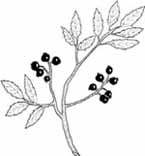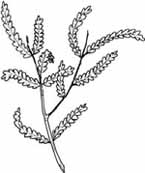Module 13: Non Timber Forest Products: Growing Opportunities
Lesson Two - NTFPs: A Natural History
LESSON TWO - NTFPs: A NATURAL HISTORY
 |
|
Beaked hazel
|
For thousands of years, Native peoples of Nova Scotia have been coexisting with the natural world around them. Traditionally, everything that First Nations peoples used came from the land and water. Shelters were constructed of readily available materials such as wooden poles, rushes, conifer boughs and bark from a number of tree species. Foods were gathered and stored. Ceremonial items were fashioned from natural products. Medicinal plants were sought out when required, or stored until needed. Every facet of the landscape featured useful materials that required a deep knowledge of the environment.
The pattern of human migration across the North American continent ensured that plant species were moved, often over vast distances. Those species that First Nations peoples valued were spread across the landscape by transporting seeds or growing stock. Local populations of plants were dispersed to other regions where, if conditions were suitable, the plants grew and were used by people in that area.
As important as the plants, however, was the knowledge that accompanied them. As the plants were spread to other cultures, traditional knowledge of their ecology and use became ingrained in local groups of people. This cultivation of knowledge became as important as the plants themselves.
The diets of early First Nations peoples of Nova Scotia are often assumed to have been mainly composed of fish and meat. While fish were very important (and shellfish in coastal areas and river estuaries), nuts and fruits were staples to most First Nations peoples. They were harvested across the landscape according to time of year and abundance.
Here is a short list of plant foods traditionally important to First Nations communities in Nova Scotia:
 |
|
Blueberry
|
Acorns (Quercus rubra)
Beaked hazelnuts (Corylus cornuta)
Beech nuts (Fagus grandifolia)
Blueberries (Vaccinium angustifolium)
Bunchberry (Cornus canadensis)
Cranberries (Vaccinium macrocarpon)
Fiddleheads (Matteuccia struthiopteris)
Foxberries (Vaccinium vitis-idaea)
Gooseberries (Ribes hirtellum)
Hawthorn (Crataegus sp.)
Labrador tea (Ledum groenlandicum)
Partridgeberry (Mi tchella repens)
Raspberry (Rubus strigosis)
Strawberries (Fragaria virginiana)
Wild rose (Rosa virginiana)
Most nuts and berries could be dried and stored for consumption during the winter, when plant foods were scarce.
Depending on seasonal conditions, gathering plant foods could be easier and less energy-consuming than hunting. Meat, however, contains much more protein and fat, which are essential for survival during cold winter periods. Animals also provided other products, including bones and fur, that were used for tools and clothing.
Plants provided the means for harvesting fish, and plant fibres were used to weave fishing lines and nets. Hawthorns were made into fish hooks.
 |
|
Rose hips
|
Early documentation by European explorers and settlers indicate that on many occasions First Nations peoples came to their aid. Many settlers did not have the knowledge essential to live off the land. During winter, when food was hard to come by, many people perished or required the help of First Nations people. The disease scurvy was especially common, and simple remedies provided by First Nations communities helped stave off this often fatal condition. We now know consuming any source of Vitamin C prevents scurvy, and that many sources of this essential vitamin are found in nature. For example, the fruit of wild roses, called hips, contain more Vitamin C than oranges. Even spruce needles and bark contain enough Vitamin C to prevent scurvy. Clearly, traditional knowledge of the forest and how to use its bounty was the key to surviving winter in Nova Scotia and other parts of North America.
 |
|
Mountain ash berries
|
Perhaps the most famous written records of an early explorer in this region are those of Samuel de Champlain, who wintered in the Maritime Provinces during the early 1600s. Champlain's writings indicate he and his expedition members made use of serviceberries, hazelnuts, currants and “certain small roots”. Champlain produced a map of New France in 1632, noting locations he felt were culturally or economically significant. Included was a “place where natives dry raspberries and blueberries each year.”
In attempting to transplant European agricultural practices to their New World, early settlers found that reliance on non-timber forest products remained important. Crops failed, contemporary medicines were in short supply, and the climate was extremely harsh. Gathering berries, nuts and maple sugar remained a vital activity until reliable agricultural methods were found. Even after agriculture was well established, however, collecting foods, medicines, fodder for livestock, and construction materials from the forest was common.
 |
|
Sweet fern
|
Migration of European peoples brought change to the landscape of Nova Scotia. Forests were cleared for agriculture, trees harvested for wood products and roads constructed for access to most areas of the province. Immigrants brought new plants with them, purposely or not. It is now often difficult to ascertain whether some plant species are indigenous to Nova Scotia. One thing, however, has not changed: the human desire to utilize and benefit from forest products.
Now, perhaps more than ever, natural products have an appeal to most people as they pursue healthier lifestyles. An endless array of products claiming to be "all natural" are common on store shelves. Often the manufacturer's name implies a bond with the wild, untamed world: "frontier", "backwoods", "wilderness", and "forest hearth" all appeal to the consumer. The seller of non-timber forest products can add market value by using the right words!
 |
|
Birch bark
|
Bark from the trunks of white birch trees (Betula papyrifera) was one of the First Nations peoples' most widely used materials. From it can be made construction materials, canoes, eating utensils, bedding, insulation for clothing,and various household items. It is also a very flammable substance for use in fire-starting.
Hemlock bark (Tsuga canadensis) was a commodity formerly collected from certain areas of the Nova Scotia forest in large quantities. The bark of this tree contains tannin, a substance that is used in tanning animal hides. The trees were cut and a spade-like tool used to peel the bark from the trunk. Usually no other part of the tree was used. Reports exist of being able to walk and jump for miles on the stripped trunks of hemlocks without ever touching the ground.
